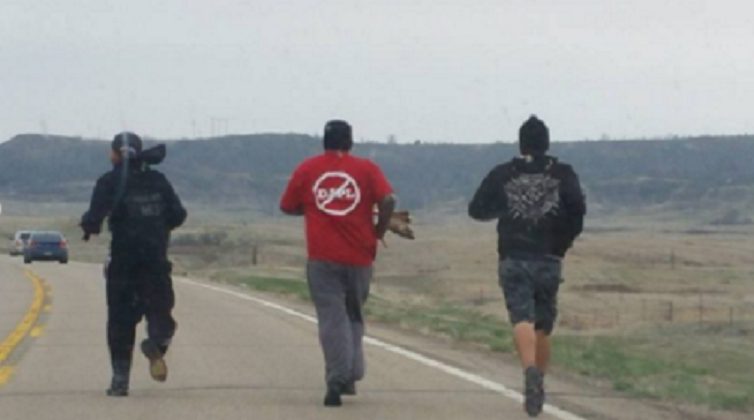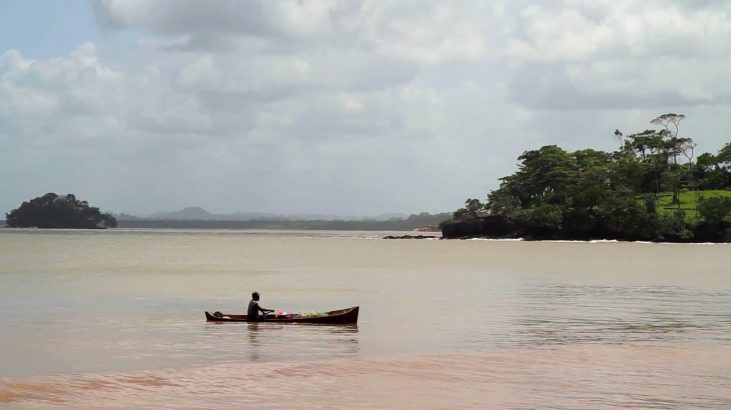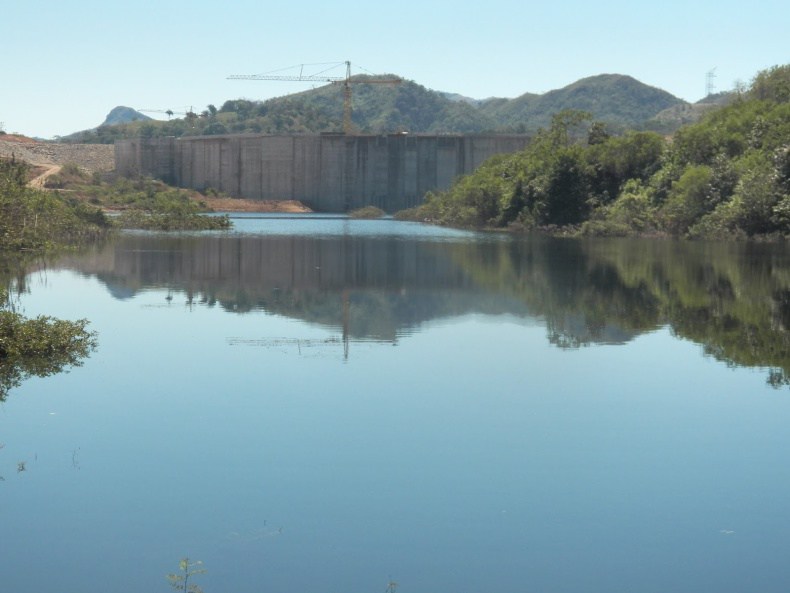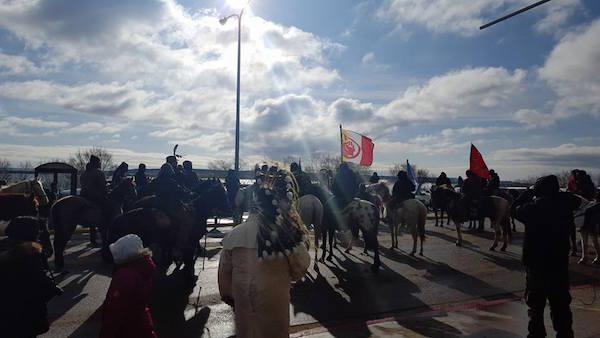
by Deep Green Resistance News Service | May 2, 2016 | Protests & Symbolic Acts
Omaha, NE – In solidarity with the ongoing fight against the Dakota Access pipeline, a group of Native and Non-native youth have organized a 500-mile spiritual relay run from Cannonball, ND to the district office of the United States Army Corps of Engineers (USACE) in Omaha, NE. The run is titled “Run For Your Life: No DAPL.” It departed the Cannonball community on April 24th, 2016 and plans to arrive in Omaha on May 3rd, 2016. The intention of the run is to deliver an unified statement to the USACE in resistance to the oil pipeline that proposed to cross beneath sacred water needed for life. The runners will will also turn over a petition calling for a full Environmental Impact Statement (EIS) to be conducted on the Bakken pipeline.
The running group is currently in Lake Andes, SD and plans for one day of rest, departing for Santee, NE on Thursday, April 28th.The participating runners are comprised of concerned citizens from across North Dakota, South Dakota, Nebraska and Iowa.
For the past several months, Native and non-Native peoples in the Midwest have been battling the construction of the Dakota Access/Bakken pipeline, a project that will go from North Dakota into South Dakota, Iowa and southern Illinois. If constructed, this large-scale pipeline will cross the 12,000 year-old Missouri River, one of the largest water resources in the United States that supports millions of people with drinking and irrigation water. The U.S. Army Corps of Engineers has stated that they will make the final decision on Dakota Access, LLC’s final permit needed to construct the Dakota Access/Bakken Pipeline no later than May 6th, 2016 .
Dakota Access Pipeline (DAPL), owned by Energy Transfer Partners, L.P., is proposed to transport 450,000 barrels per day of Bakken crude oil from the lands of North Dakota to Patoka, Illinois. Dakota Access Pipeline is proposed to cross under the Missouri River twice, and poses as a threat to the sacred waters that the entire breadbasket of America depends on. The construction of Dakota Access will threaten everything from farming and drinking water to entire ecosystems, wildlife and food sources surrounding the Missouri.
The group asks that “Everyone stand with us against this threat to our health, our culture, and our sovereignty. We ask that everyone who lives on or near the Missouri River and its tributaries, everyone who farms or ranches in the local area, and everyone who cares about clean air and clean drinking water stand with us against the Dakota Access Pipeline!”
Dallas Goldtooth, Organizer with Indigenous Environmental Network, said: “We can not accept the risks an oil spill will cause upon the heartland of America. We cannot accept the trespassing across Oceti Sakowin lands by Big Oil. We cannot accept locking ourselves into more fossil fuels when Mother Earth demands us to leave fossil fuels in the ground. This Dakota Access pipeline is all risk, no reward. Simple as that.”
Follow the group’s Facebook page for run updates, and sign and share the group’s petition.

by Deep Green Resistance News Service | Apr 22, 2016 | Colonialism & Conquest
By Intercontinental CryBangkukuk: The Indigenous Rama Speak Out Bangkukuk: The Indigenous Rama Speak Out Against Nicaragua’s Interoceanic Grand CanalAgainst Nicaragua’s Interoceanic Grand Canal
The Rama people have lived on the Atlantic Coast of Nicaragua for thousands of years, long before the existence of the nation state. Nicaragua’s Law 445 recognizes indigenous ownership of traditional lands and natural resources; but for decades, settlers from the Pacific have taken vast amounts of Rama territory causing massive deforestation and threatening the Rama way of life.
In 2013 the Nicaraguan government passed Law 840 allowing the Chinese investment firm Hong Kong Nicaragua Development to construct an interoceanic canal without any public consultation or debate. Though the government hails the project as the means to lift the nation out of poverty, hundreds of thousands of Nicaraguans would be forced from their land and the environmental impact could devastate the country’s rich ecosystem of lakes, rivers, and forests. Almost half of the 160 mile canal would cut through the Southern Atlantic Autonomous Region which is home to the Rama.
In 2014 it was announced that the proposed canal route would cut directly through the Rama village of Bangkukuk, removing the community from their land and way of life. Since then, government officials have been pressuring community members to sign land concessions without legal consultation. In response, community leaders and local officials have partnered with indigenous rights groups to combat this land grab by bringing their case to the Inter-American Court.
The film Bangkukuk is a collaboration between Art of Solidarity and village leaders aimed at sharing their story with the international community. This short trailer is just a glimpse into an upcoming feature-length documentary film that will give voice to the many communities, organizations, and activists at the front lines of the indigenous rights and anti-canal movements in Nicaragua.

by Deep Green Resistance News Service | Apr 13, 2016 | Biodiversity & Habitat Destruction, Indigenous Autonomy
Featured image: The Barro Blanco Dam will have a disastrous effect on Ngäbe communities inside the Comarca Ngäbe-Bugle and campesino communities also living on the banks of the river. Photo Oscar Sogandares
By Jennifer Kennedy/ Intercontinental Cry
Ngäbe communities in western Panama are calling for support from the international community after officials from the Honduran-owned energy company, GENISA, warn that they will soon be evicted from their homes to make way for the flooding of the Barro Blanco hydro dam reservoir.
Ricardo Miranda, a spokesperson from the Movimiento 10 De Abril (M10) resistance movement, told IC, “The situation for the Ngäbe people is critical and tense with the imminent closure of the Barro Blanco gates. The government has announced that the gates will be closed in April and before that people will be evicted.”
The 28.84 megawatt dam is being constructed by GENISA on the Tabasará River in the western province of Chiriquí. Although located in Chiriquí, the dam will have a disastrous impact on Ngäbe communities inside the Comarca Ngäbe-Bugle and campesino communities also living on the banks of the river.
Once the gates are closed and the reservoir is filled, the subsistence fishing practices of all nearby communities will take a severe hit; cultivable land will be irrecoverably lost and the Ngäbe themselves will lose their school, their cultural centre and two sets of ancient petroglyphs that are of considerable cultural and archaeological importance.
Before this happens, Ngäbe-Bugle and campesino communities in the impact area will be forced from their homes.

A celebratory gathering to honor the petroglyphs. Photo: Oscar Sogandares
GENISA officials have reportedly claimed that the dam’s reservoir will be filled on April 15.
M10 has been fighting relentlessly to halt the project since the movement was founded in 1999, when a group of Ngäbe protesters were arrested for opposing the dam. Working along side them is Movimiento De Septiembre 22 (M22), an independent Ngäbe movement whose members follow Mama Tata, a religion that’s centered on cultural revival. M22 made international headlines in 2015 when they blocked the entrance to the dam for 38 consecutive days, until riot police, claiming to act in self-defense, unleashed pepper spray and batons on the Ngäbe activists, women and children among them.

Edilma Pinto, 17, suffered a fractured foot during the 2015 police crackdown. (Photo: Oscar Sogandares
Silvia Carrera, chief of the Comarca Ngäbe-Bugle, who is currently in negotiations with the government, was initially supportive of M10 and M22’s resounding calls to cancel the project. However, Carrera changed her position after the July crackdown, signing a document with the government in favour of the project.
Under that document, the dam is forbidden to proceed until an agreement is reached with the region’s indigenous and campesino stakeholders. Unfortunately, this provision appears to have slipped off the table. Flood tests are now taking place and according to the international NGO Carbon Market Watch (CMW), there remains a worrying lack of requisite dialogue between the government and the communities affected by the hydro dam.
GENISA itself has never sought the free, informed, and prior consent (FPIC) of the indigenous communities living on the banks of the Tabasará river.
Miranda says affected communities are as adamant as ever that the project be stopped. Together, they are urgently calling on the international community for support.
“We are asking for international solidarity in the struggle for water and the Tabasará River. We are asking people to demand the definitive cancellation of Barro Blanco and to demand an end to the violence against the Ngäbe which is being inflicted by the project,” he said.
GENISA isn’t the only one that’s failing to live up to stakeholder expectations.
The US$78M project, registered under the United Nation’s CDM carbon offsetting mechanism, has received significant financing from The Netherlands Development Finance Company (FMO), The German Investment & Development Company (DEG) and the Central American Bank for Economic Integration (CBIE).
The FMO and DEG previously admitted to failing their own due diligence tests during the course of financing. A report published in May 2015 by FMO’s internal Independent Complaints Mechanism (ICM) states, “Lenders should have sought greater clarity on whether there was consent to the project from the appropriate indigenous authorities prior to project approval.”
In June 2015, however, the lenders took things one step further by threatening the Panamanian government when it temporarily suspended Barro Blanco’s construction.
Denouncing the developments banks, Miranda told IC that “the FMO and DEG are complicit in the serious violations of human rights on the Tabasará River.”

by Deep Green Resistance News Service | Apr 10, 2016 | Indigenous Autonomy, Obstruction & Occupation
Featured image: The spirit riders at Standing Rock show support for keeping the Missouri River waters clean. Image by Steve Sitting Bear.
By Chelsey Luger / Indian Country Today Media Network
In the coming weeks or maybe even days, the U.S. Army Corps of Engineers will issue a decision as to whether or not they will allow the Dakota Access Pipeline, also known as the Bakken Pipeline, to be constructed.
Until then, citizens and allies of the Oceti Sakowin (Seven Council Fires of the Great Sioux Nation) will continue to protest the pipeline, urging stakeholders to recognize the devastation that would ensue should the pipeline be built.
“The DAPL poses a threat to our people, cultural and historically significant areas,” said Paula Antonie, Chair of Shielding the People and a Rosebud Sioux tribal citizen. “We will stand by our Hunkpapa relatives in defending against any major environmental, public health and safety hazards within our treaty territory.”
The proposed pipeline would stretch for thousands miles across four states beginning in western North Dakota and ending in Indiana. It would cross the Missouri River mere feet away from the northern border of the Standing Rock Reservation, threatening to contaminate and destroy the waters.
“When this proposed pipeline breaks, as the vast majority of pipelines do, over half of the drinking water in South Dakota will be affected,” said Joye Braun, a community organizer from the Cheyenne River reservation. “How can rubber-stamping this project be good for the people, agriculture and livestock? It must be stopped.”
While the oil industry would like the public to believe that pipelines are a clean and efficient way of transporting oil with little risk, the data suggest otherwise. According to the Associated Press, there were 300 oil pipeline breaks in North Dakota alone during 2012–2013, and none of them were reported to the public. North Dakota is the second-largest oil-producing state after Texas.
Delegates from the Standing Rock Sioux Tribe have already met with representatives from several federal agencies, including the Army Corps, urging them to reevaluate the environmental impact of the project. The interests of the Standing Rock Sioux were not taken into consideration in the initial environmental assessment. While the Corps decision will have an influence, it won’t be the end of the fight.
“The Corps will get sued either way,” explained Standing Rock Chairman Dave Archambault. “If they approve of the pipeline, the Standing Rock Sioux Tribe will sue them. If they reject it, Energy Transfer Partners will sue them.”
Archambault explained that unlike Keystone XL, which President Obama rejected last November, an executive order will not hold the same weight in this project. While Keystone XL was a federal project crossing the U.S.–Canada border, Dakota Access is a private project and does not cross an international boundary. In addition, most of the landowners along the way have already issued voluntary easements on their property.
Meanwhile, several grassroots groups, tribal citizens, and concerned allies who oppose the pipeline have banded together to work on getting their message out. This conglomerate of activists are calling themselves “Chante tin’sa kinanzi Po” or “People, Stand with a Strong Heart!” Their mission statement says this:
“ ‘They claim this mother of ours, the Earth, for their own use, and fence their neighbors away from her, and deface her with their buildings and their refuse.’ —Chief Sitting Bull. His way of life is our way of life—standing in opposition to the Dakota Access Pipeline is our duty.”
On April 1, Chante tin’sa kinanzi Po set up a horse ride to celebrate the founding of a Spirit Camp that they erected along the route of the proposed pipeline near the community of Cannon Ball in North Dakota.
The camp is called Inyan Wakhanagapi Othi or Sacred Rock, which translates as the original name of the Cannon Ball area.
Dozens of riders and supporters joined in the spirit ride. All are welcome to show support at the campsite, which will be active for an undetermined period of time, or until no longer necessary. They urge all supporters to write letters to the Corps on behalf of tribal interests.
“We do not need oil to live, but we do need water,” said Waniya Locke, a descendant of the Standing Rock nation. “And water is a human right, not a privilege.”








